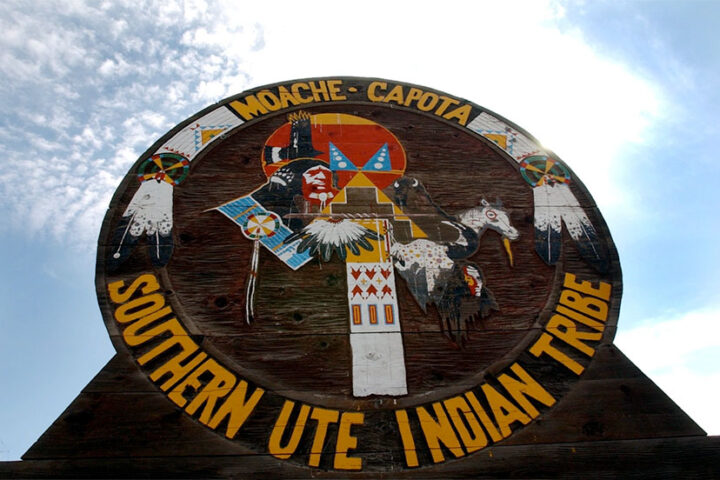PHOTO: Southern Ute Growth Fund Office Building.
“The Southern Ute Indian Tribe is unique,” one tribal Web site says matter-of-factly — a statement few would argue with…
— from ‘The Ute Paradox’ by Jonathan Thompson in the High Country News, July 2010.
As we’ve noted, the maintenance issues along County Road 500 involve the government responsible for the maintenance: Archuleta County…
…and the tribe that owns much of the land through which the road runs: the Southern Ute Indian Tribe (SUIT).
SUIT has shared a Creation Story — as told by tribal member Alden Naranjo — on their website, and you can read the story here.
The story begins like this:
In the ancient times only Sinawav, the Creator and Coyote lived on the earth. They had come out of the light so long ago, that no one remembered when or how. The Earth was young and the time had come to increase the people. Sinawav gave a bag of sticks to Coyote and said “Carry these over the far hills to the valleys beyond.” He gave specific directions Coyote was to follow and told him what to do when he got there. “You must remember, this is a great responsibility. The bag must not be opened under any circumstances until you reach the sacred grounds…”
We can immediately guess, based on those instructions, that Coyote is going to open the bag at the wrong time, and make a mess of things. When he opens it, he releases all of the various Indian tribes, who run off to every corner of the land, speaking their various tongues. Sinawav is naturally disappointed in Coyote’s dismal failure to follow directions.
“You foolish thing, you do not know what a fearful thing you have done.”
Coyote finally confessed. “I tried to catch them. I was frightened. They spoke in strange tongues that I could not understand.”
“Those you let escape will forever war with the chosen ones. They will be the tribes which will always be a thorn in the sides of the Utes,” said Sinawav.
“The Utes, even though they are few in number, will be the mightiest and most valiant of heart.”
The tribes that proved the most problematic, of course, arrived from across the Atlantic Ocean. The Spanish, and then the Anglos.
As mentioned in Part Two, the U.S. government granted the Ute Indians about 56 million acres of land in 1868, covering most of western Colorado. But by 1895, the Southern Utes had been relocated to a reservation measuring 15 miles by 110 miles, in the southwest corner of the state.
One thing was not apparent in 1895, however. The 677,000-acre Southern Ute reservation sat atop some of the finest oil and gas deposits in the American West.
In 1966, SUIT elected a young leader, Leonard Burch, as Chairman of the Southern Ute Indian Tribal Council, and shortly thereafter, hired a Durango attorney named Sam Maynes to explore ways to give the Tribe more control of its oil and gas resources. Private companies had been shipping SUIT gas for a couple of decades already, but were paying the Tribe — as it turned out — relatively little in royalties.
In 1975, America was just beginning to recover from the first Arab oil embargo, during which the price of oil tripled from $3 a barrel to $12. That same year, Chairman Burch and the Southern Utes joined 24 other tribal leaders to form the Council of Energy Resource Tribes to consolidate their political power. The Southern Utes used a federal grant to bring in experts to analyze their energy resources, and realized that companies were cheating the Tribe by undervaluing its gas. From Jonathan Thompson’s High Country News article mentioned above:
The tribe’s energy department also took over the auditing of leasing from the feds, a move made by only a handful of other tribes, which helped uncover potential cheating. [In 2010], based on information from Southern Ute auditors, the feds fined BP America $5.2 million for underreporting the amount of gas it had been producing on Southern Ute lands.
Chairman Burch made a daring move in 1992, when the Tribe received $8 million from the federal government as a result of the Colorado Ute Indian Water Rights Settlement Agreement. From Mr. Thompson’s article:
Rather than leverage [the money] for short-term gain, the tribe formed its own gas production company, the first iteration of Red Willow. If outsiders could get rich drilling the tribe’s land, Ute leaders and advisers figured, why couldn’t the tribe itself? As obvious as the idea may sound, it was revolutionary at the time.
Thus, while federal policy shuffled toward granting tribes more political sovereignty, the Southern Utes took giant leaps toward what’s known as practical sovereignty. They took “advantage of the federal self-determination policy… promised by law but denied by federal paternalism and control,” report Stephen Cornell and Joseph Kalt at the Harvard Project on American Indian Economic Development…
When Red Willow took over 54 gas wells in 1995, it quadrupled their production within nine months…
When a sovereign tribe operates an oil or gas well, it is exempted from many of the outside government taxes, cutting overhead by as much as 30 to 40 percent.
“That gave the tribe a huge competitive margin,” says [David Lester, head of the Council of Energy Resource Tribes]. “Plus, they hired experienced hands to run the company. They really did a good job of recruiting and hiring quality, honest, really good employees, so that the core team really could produce what the tribe wanted done…”
According to Mr. Thompson, writing in 2010, the Tribe’s net worth stood at somewhere between $3.5 billion and $14 billion.
It would appear that SUIT has made a number of savvy decisions over the past half-century.
What will their decision be, regarding the maintenance issues on County Road 500?


